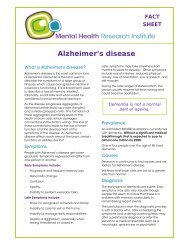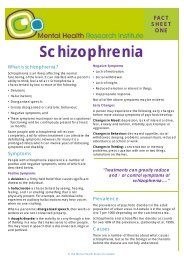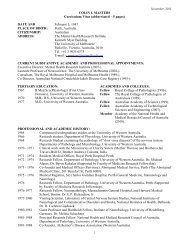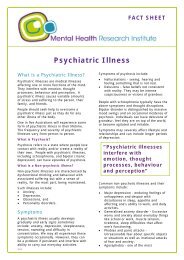MHRI Autumn Newsletter 2010 - Mental Health Research Institute
MHRI Autumn Newsletter 2010 - Mental Health Research Institute
MHRI Autumn Newsletter 2010 - Mental Health Research Institute
- No tags were found...
You also want an ePaper? Increase the reach of your titles
YUMPU automatically turns print PDFs into web optimized ePapers that Google loves.
Towards understanding March <strong>2010</strong>Towards understanding March <strong>2010</strong>Towards understanding March <strong>2010</strong>MESSAGE FROM THE DIRECTOR<strong>Mental</strong> health at last became the focus of community attentionon Australia Day when Professor Patrick McGorry was awardedAustralian of the Year.A leading international researcher, clinician and advocatefor youth mental health reform, Professor McGorry has usedthe honour to bring mental health issues into the public eyethrough numerous interviews and appearances.The Australian of the Year award is presented each year to aleader in the community who is a role model for us all. It isinspiring to everyone who works in this sector, as well as thepeople who experience a mental illness, to see Professor McGorryrecognised for his contribution to creating a better Australia.Meanwhile, both State and Federal governments havedemonstrated their commitment to mental health research bysupporting the Melbourne Neuroscience Project. The projectcomprises state of the art research facilities currently underconstruction at the University of Melbourne on Royal Paradeand a second building at the Austin Hospital in Heidelberg.The Parkville Neuroscience facility will feature six levels ofintensive laboratories with four levels of car parking below.It is designed to capture rainwater from the roof for reusezinc discovery<strong>Research</strong>ers in the Oxidation Biology Laboratory think amyloidplaques may damage neurons by trapping metals required forsynaptic transmission. They analysed mice with reduced overallzinc and the transporter that controls synaptic zinc levels (zinctransporter-3, or ZnT3) “knocked out”. With age, the micedeveloped neurophysiological and cognitive deficits resemblingAlzheimer’s disease.In 2001, other scientists concluded that learning and memory werenot affected in this type of mouse model. However, the <strong>MHRI</strong>team suspected the mice had been tested too young, thinking thatcognitive problems might crop up as the mice got older.Using the Morris water maze they gauged spatial learning andmemory by observing how quickly animals remember the locationof a submerged platform. While at 3 months the ZnT3 knockoutmice did just as well as regular mice, by the time they were sixmonths old they took more than twice as long to find the platform.PROFESSOR COLIN MASTERSwithin the building and will use a solar system to heat water.The practicalities of sharing resources including equipment,administrative functions and IT networks will also improve thecost-effectiveness of all participating organisations.Building progress is well ahead of schedule for both buildingsand there is a buzz of anticipation about the synergy thatwill occur with the co-location of so many researchers andscientists and we look forward to accelerated progress in ourunderstanding of illnesses that affect the brain.My colleagues and I are preparing for the opportunities offeredby our expansion into the new facilities next year, while alsomaintaining our current premises in Oak Street. These areexciting times for us and we thank you for your help in makingthis possible.Colin L. Masters MDExecutive Director,<strong>Mental</strong> <strong>Health</strong> <strong>Research</strong> <strong>Institute</strong>Laureate Professor,The University of MelbourneA western blot of brain tissue showed that as well as cognitiveimpairment, ZnT3 knockout mice had age-related reductions in anumber of synaptic and plasticity-related proteins.At any age, the ZnT3 knockout mice had significantly less hippocampalzinc than controls. However, even the healthy control mice had a 23%drop in brain zinc levels between three and six months, indicating thatsome zinc loss occurs with age.Ageing brains also gradually lose ZnT3. The researchers found thatthe transporter loss can be seen in both mice (1.9 and 8.7 monthsof age) and people (48-91 years old). Analysis of post-mortem braintissue from people who had Alzheimer’s disease showed even greaterdecreases in brain ZnT3 levels, relative to age-matched healthy people.The research suggests that the losses of zinc and ZnT3 are importantin ageing and disease pathophysiology. In Alzheimer’s disease, as wellas the drop in ZnT3, there is amyloid soaking up the zinc.“Without the transporter, zinc pools outside the cell and theintracellular compartment is deficient,” says Professor Ashley Bush.“The amyloid is this great big zinc fly trap.”He believes that this research gives insight into why the drugPBT2, a zinc/copper ligand which his laboratory found could boostcognition in mouse models of Alzheimer’s disease and is currently inclinical trials, actually works.Volunteer’s viewFifteen years ago, Bill Moseley heard Professor Colin Masterstalking about his research on the radio. He was calling forhealthy ageing volunteers to take part. Bill had recently retiredand, encouraged by his wife, decided he could spare the timeto help out.Bill didn’t have any friends or family with dementia. He justthought it was a worthwhile cause, and one that he was in aposition to help.Since then Bill has completednumerous memory tests, MRI scansand blood tests. Most recently,he had a lumbar puncture for theAustralian Imaging Biomarker andLifestyle (AIBL) study of ageing.In recent years, researchers havefound that the cerebrospinalfluid (CSF) biomarkers extractedthrough a lumbar puncture can beuseful for diagnosing Alzheimer’sdisease early, even before obvioussymptoms can be seen. It may alsoshow us which patients are likelyto have more aggressive forms ofthe disease. But researchers needto further validate the use of CSFbiomarkers before they could beused in general clinical practice.So far Bill is one of nine AIBLparticipants who have volunteeredto do a lumbar puncture, and he’s encouraging others tojoin him.“It was actually far easier than doing an MRI,” says Bill.“The only thing that hurt was a slight prick when he putthe local anaesthetic in. When he did the lumbar punctureI had a slight feeling in the top of my legs – light pressure.It wasn’t painful.”“We think our drug takes the zinc out of the amyloid and puts itback into the cell,” said Professor Bush.An essential trace mineral, Zinc is required for the metabolic activityof 300 of the body’s enzymes, and is considered essential for celldivision and the synthesis of DNA and protein. Zinc is found inseafood, beef, lamb and poultry.BILL MOSELEY“The doctor showed me what he’d taken out and told me itwas about 5% of the total fluid. I didn’t think it would beclear, but it was. You would never see anything like that if youdidn’t volunteer for these things.”Asked whether he was intimidated when asked to have alumbar puncture, Bill says, “The only thing we were worriedabout was finding the right place”.The staff from AIBL fully explainedthe procedure to him. He alsodiscussed it with his trusted GP,who confirmed that there wasminimal risk involved. There was norecovery time needed. He was off toplay bowls the next day and wentsky-diving the following weekend!An active octogenarian, Bill hasalways been interested in scientificand technical things, so he enjoysthe opportunity to see behind thescenes of research. But mostly, hesees it as part of his contributionto the community. Both he and hiswife volunteer in their local area,and taking part in Alzheimer’sresearch was just another way tolend a hand.Living in a retirement village Billhas seen a lot of people in thehigh care area who are sufferingdementia. Some who do not even recognise their loved ones.“If what I’m doing can help people, not these people butsomeone in the future - maybe even in my own family – won’tit all be worthwhile?” he says.If anyone who is already taking part in the AIBL study wouldlike to volunteer for a lumbar puncture, or find out more aboutit, please contact Alicia on 9389 2923.In briefNew supporters fund equipmentReg and Judy Dixon recently donated a $50,000 liquidnitrogen freezer, which <strong>MHRI</strong> will use to store and preserveblood and cerebrospinal fluid samples collected in theAIBL study.The freezer keeps its contents at a temperature of-194 degrees Celsius. Samples stored within are kept inprime condition for over a decade.The couple chose to support this project in memory of Reg’smother, Ruth Dixon, who suffered from Alzheimer’s diseasebefore she passed away in 2009.Dr Kathryn Ellis, who coordinates <strong>MHRI</strong>’s part of the AIBLstudy, thanked the couple when they visited the <strong>Institute</strong> tosee the new equipment.“This equipment is a great asset to the <strong>Institute</strong>,” she said.“It allows our samples to be kept in optimal conditionsso that they can continue to be used to test new scientificdiscoveries as they occur.”This is particularly important now as researchers acrossthe world work towards compatible methods for collatingparticipant information in studies of ageing. The AIBL cohortof over 1000 participants is not only the largest of its kind inAustralia, but now part of a wider group that can be analysedto better understand factors that can impact dementia.Reg and Judy Dixon with their donated liquid nitrogen freezer.Giving in celebrationThe <strong>Institute</strong> is grateful that Naomi and Joel recently choseus to be one of three charities to benefit from donations inlieu of gifts for their wedding. Inviting friends to support ourresearch is a great way to engage others with our cause whileavoiding accumulating unwanted belongings.If you would like to celebrate the milestones in your lifeby helping life-changing research, we can provide tailoreddonation forms or help you set up your own website wherepeople can also leave you messages. We will also thank allguests who donated to us in your honour and let you knowwho has done so.Challenge conqueredForty-seven people completed the Anaconda Adventure Racein December for One in Five’s annual Extreme Challenge,raising over $45,000 for mental health research.Craig Eldridge was one of the competitors. In addition toasking friends and relatives to sponsor him to complete thechallenge, Craig also encouraged his employers at Esso/BHPBilliton to donate last month’s $5,074.80 Safety IncentiveScheme cheque to One in Five.The scheme is based on the number of HAZOBs submittedby construction crews; management visits; site safetyinspections; and is converted into points for dollars. Eachmonth by rotation, crews at LIP, KTT, Retrofit Offshore and theWarehouse can donate these dollars to their chosen charity.Extreme Challenge organisers, Linda Karafili and Ryan Wavish (left) were joined byOne in Five Chairperson, Julia Mason (right) to receive the Safety Incentic Schemecheque from Craig Eldridge (centre right).2 34













